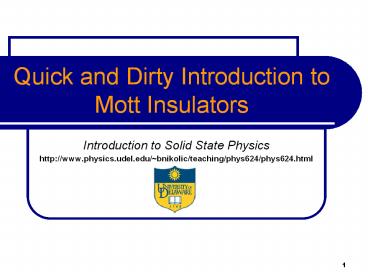Quick%20and%20Dirty%20Introduction%20to%20Mott%20Insulators - PowerPoint PPT Presentation
Title:
Quick%20and%20Dirty%20Introduction%20to%20Mott%20Insulators
Description:
Introduction to Solid State Physics http://www.physics.udel.edu/~bnikolic ... Mott Insulator: A solid in which strong repulsion between the particles impedes ... – PowerPoint PPT presentation
Number of Views:251
Avg rating:3.0/5.0
Title: Quick%20and%20Dirty%20Introduction%20to%20Mott%20Insulators
1
Quick and Dirty Introduction to Mott Insulators
- Introduction to Solid State Physics
http//www.physics.udel.edu/bnikolic/teaching/phy
s624/phys624.html
2
Weakly correlated electron liquid Coulomb
interaction effects
When local perturbation potential
is switched on, some electrons will leave this
region in order to ensure constant
(chemical potential is a thermodynamic potential
therefore, in equilibrium it must be homogeneous
throughout the crystal).
3
Thomas Fermi screening
- Except in the immediate vicinity of the
perturbation charge, assume that is
caused by the induced space charge ? Poisson
equation
4
Mott Metal-Insulator transition
- Below critical electron concentration, the
potential well of the screened field extends far
enough for a bound state to be formed ? screening
length increases so that free electrons become
localized ? Mott Insulators (e.g., transition
metal oxides, glasses, amorphous semiconductors)!
5
Metal vs. Insulator
- Fundamental requirements for electron transport
in Fermi systems - quantum-mechanical states for electron-hole
excitations must be available at energies
immediately above the ground state since the
external field provides vanishingly small energy - these excitations must describe delocalized
charges that can contribute to transport over the
macroscopic sample sizes.
?
?
T
T
6
Metal-Insulator Transitions
Mott Insulator A solid in which strong repulsion
between the particles impedes their flow ?
simplest cartoon is a system with a classical
ground state in which there is one particle on
each site of a crystalline lattice and such a
large repulsion between two particles on the same
site that fluctuations involving the motion of a
particle from one site to the next are suppressed.
7
Energy band theory
Electron in a periodic potential (crystal) ?
energy band (
1-D tight-binding band)
N 1
N 2
N 4
N 8
N 16
N ?
EF
kinetic energy gain
8
Band (Bloch-Wilson) insulator
Wilsons rule 1931 partially filled energy band
? metal otherwise ?
insulator
metal
insulator
semimetal
Counter example transition-metal oxides,
halides, chalcogenides Fe metal with
3d6(4sp)2 FeO insulator with 3d6
9
Mott gedanken experiment (1949)
electron transfer integral t
energy cost U
d atomic distance
d ? ? (atomic limit no kinetic energy gain)
insulator d ? 0 possible metal as seen in
alkali metals
Competition between W(2zt) and U ?
Metal-Insulator Transition e.g. V2O3, Ni(S,Se)2
10
Mott vs. Bloch-Wilson insulators
- Band insulator, including familiar
semiconductors, is state produced by a subtle
quantum interference effects which arise from the
fact that electrons are fermions. - Nevertheless one generally accounts band
insulators to be simple because the band theory
of solids successfully accounts for their
properties - Generally speaking, states with charge gaps
(including both Mott and Bloch-Wilson insulators)
occur in crystalline systems at isolated
occupation numbers where
is the number of particles per unit cell. - Although the physical origin of a Mott insulator
is understandable to any child, other properties,
especially the response to doping
are only partially understood. - Mott state, in addition to being insulating, can
be characterized by presence or absence of
spontaneously broken symmetry (e.g., spin
antigerromagnetism) gapped or gapless low energy
neutral particle excitations presence or absence
of topological order and charge
fractionalization.
11
Theoretical modeling Hubbard Hamiltonian
Hubbard Hamiltonian 1960s on-site Coulomb
interaction is most dominant
band structure
correlation
e.g. U 5 eV, W 3 eV for most 3d
transition-metal oxide such as MnO, FeO,
CoO, NiO Mott insulator
- ? Hubbards solution by the Greens function
- decoupling method
- ? insulator for all finite U value
- Lieb and Wus exact solution for the ground
- state of the 1-D Hubbard model (PRL 68)
- ? insulator for all finite U value
12
Trend in the Periodic Table
U ?
U ?
13
Solving Hubbard model in dimensions
- In ?-D, spatial fluctuation can be neglected.
- ? mean-field solution becomes exact.
- Hubbard model ? single-impurity Anderson
- model in a mean-field bath.
- Solve exactly in the time domain
- ? dynamical mean-field theory
14
From non-Fermi liquid metal to Mott insulator
NOTE DOS defined even though there are no
fermionic quasiparticles.
Model Mobile spin-up electrons interact with
frozen spin-down electrons.
15
Experiment Photoemission Spectroscopy
Einsteins photoelectric effect
h? (K,?) gt W
e- (Ek,k,?)
N-particle
(N?1)-particle
Sudden approximation
EfN ?1
EiN
P( i ? ? f ?)
Photoemission current is given by
16
Mott Insulating Material V2O3
Vanadium
Oxygen
17
Phase diagram of V2O3
18
Bosonic Mott insulator in optical lattices
- Superfluid state with coherence, Mott Insulator
without coherence, and superfluid state after
restoring the coherence.































